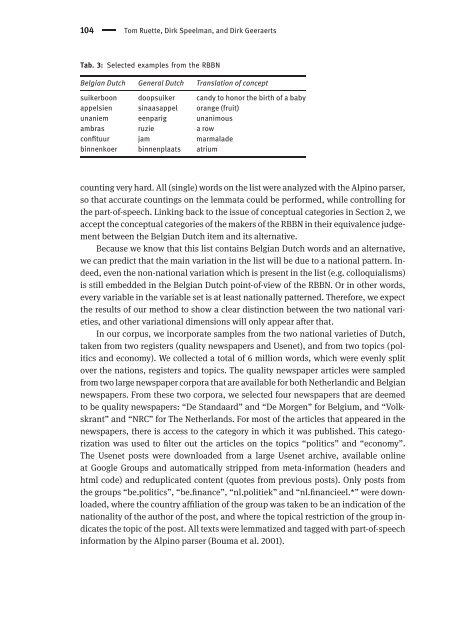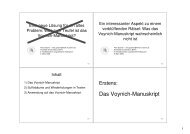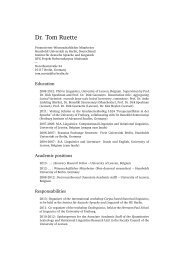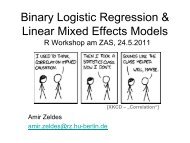Lexical variation in aggregate perspective
Lexical variation in aggregate perspective
Lexical variation in aggregate perspective
You also want an ePaper? Increase the reach of your titles
YUMPU automatically turns print PDFs into web optimized ePapers that Google loves.
104 Tom Ruette, Dirk Speelman, and Dirk Geeraerts<br />
Tab. 3: Selected examples from the RBBN<br />
Belgian Dutch General Dutch Translation of concept<br />
suikerboon doopsuiker candy to honor the birth of a baby<br />
appelsien s<strong>in</strong>aasappel orange (fruit)<br />
unaniem eenparig unanimous<br />
ambras ruzie a row<br />
confituur jam marmalade<br />
b<strong>in</strong>nenkoer b<strong>in</strong>nenplaats atrium<br />
count<strong>in</strong>g very hard. All (s<strong>in</strong>gle) words on the list were analyzed with the Alp<strong>in</strong>o parser,<br />
so that accurate count<strong>in</strong>gs on the lemmata could be performed, while controll<strong>in</strong>g for<br />
the part-of-speech. L<strong>in</strong>k<strong>in</strong>g back to the issue of conceptual categories <strong>in</strong> Section 2, we<br />
accept the conceptual categories of the makers of the RBBN <strong>in</strong> their equivalence judgement<br />
between the Belgian Dutch item and its alternative.<br />
Because we know that this list conta<strong>in</strong>s Belgian Dutch words and an alternative,<br />
we can predict that the ma<strong>in</strong> <strong>variation</strong> <strong>in</strong> the list will be due to a national pattern. Indeed,<br />
even the non-national <strong>variation</strong> which is present <strong>in</strong> the list (e.g. colloquialisms)<br />
is still embedded <strong>in</strong> the Belgian Dutch po<strong>in</strong>t-of-view of the RBBN. Or <strong>in</strong> other words,<br />
every variable <strong>in</strong> the variable set is at least nationally patterned. Therefore, we expect<br />
the results of our method to show a clear dist<strong>in</strong>ction between the two national varieties,<br />
and other <strong>variation</strong>al dimensions will only appear after that.<br />
In our corpus, we <strong>in</strong>corporate samples from the two national varieties of Dutch,<br />
taken from two registers (quality newspapers and Usenet), and from two topics (politics<br />
and economy). We collected a total of 6 million words, which were evenly split<br />
over the nations, registers and topics. The quality newspaper articles were sampled<br />
from two large newspaper corpora that are available for both Netherlandic and Belgian<br />
newspapers. From these two corpora, we selected four newspapers that are deemed<br />
to be quality newspapers: “De Standaard” and “De Morgen” for Belgium, and “Volkskrant”<br />
and “NRC” for The Netherlands. For most of the articles that appeared <strong>in</strong> the<br />
newspapers, there is access to the category <strong>in</strong> which it was published. This categorization<br />
was used to filter out the articles on the topics “politics” and “economy”.<br />
The Usenet posts were downloaded from a large Usenet archive, available onl<strong>in</strong>e<br />
at Google Groups and automatically stripped from meta-<strong>in</strong>formation (headers and<br />
html code) and reduplicated content (quotes from previous posts). Only posts from<br />
the groups “be.politics”, “be.f<strong>in</strong>ance”, “nl.politiek” and “nl.f<strong>in</strong>ancieel.*” were downloaded,<br />
where the country affiliation of the group was taken to be an <strong>in</strong>dication of the<br />
nationality of the author of the post, and where the topical restriction of the group <strong>in</strong>dicates<br />
the topic of the post. All texts were lemmatized and tagged with part-of-speech<br />
<strong>in</strong>formation by the Alp<strong>in</strong>o parser (Bouma et al. 2001).






